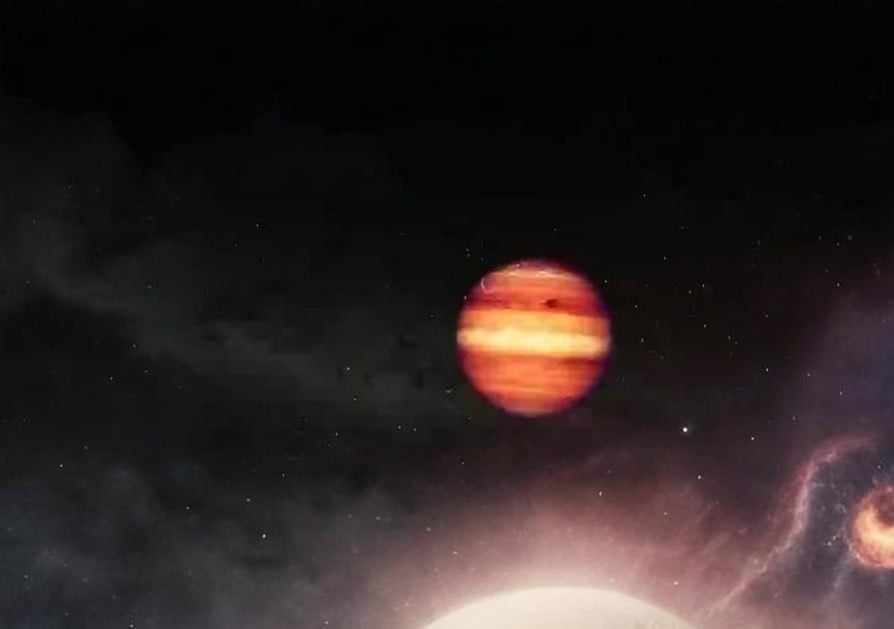Exploring SIMP J0136+0933, the Free-Floating Planet

© NASA
In the vast expanse of our universe, certain celestial bodies defy conventional classification. This challenges our understanding of planetary and stellar formation. One such enigmatic object is SIMP J013656.5+093347, commonly referred to as SIMP J0136.
Located approximately 20 light-years from Earth in the constellation Pisces, SIMP J0136 is a free-floating planetary-mass object that does not orbit a parent star.
Its unique characteristics have captivated astronomers, offering insights into atmospheric dynamics, magnetic properties, and the complexities of celestial body classification.
Discovery and Initial Observations
SIMP J0136 was first identified through infrared surveys, distinguishing itself from typical stars and planets due to its solitary existence. Its proximity to Earth and its non-stellar nature have made it an ideal subject for detailed astronomical studies. Moreover, researchers have utilized various telescopes, including the James Webb Space Telescope (JWST), to observe and analyze this object. They are aiming to unravel its many mysteries.

Physical Characteristics
- Mass and Composition. SIMP J0136 has an estimated mass about 13 times that of Jupiter, placing it in a mass range between that of large planets and small stars, a category often referred to as brown dwarfs. Despite its substantial mass, it lacks the sustained nuclear fusion at its core that characterizes true stars.
- Temperature. With a temperature around 1,098 Kelvin (approximately 825°C), SIMP J0136 is cooler than stars but warmer than most planets, contributing to its unique infrared signature.
- Rotation. Additionally, the object exhibits a rapid rotation, completing a full spin approximately every 2.4 hours. This swift rotation influences its atmospheric dynamics and magnetic field generation.
Atmospheric Dynamics and Cloud Structures
Observations have revealed that SIMP J0136’s brightness varies across different wavelengths of infrared light. This variability is attributed to several atmospheric phenomena:
- Iron Clouds: At certain wavelengths, the brightness fluctuations are linked to clouds composed of iron particles, suggesting a complex and dynamic cloud system.
- Silicate Clouds: Other wavelengths indicate the presence of clouds made up of tiny grains of silicate minerals, adding another layer of complexity to its atmospheric composition.
- Auroral Hot Spots: Bright regions observed above the clouds are thought to result from auroral activity, where charged particles interact with the magnetic field, producing localized heating and brightness.
Moreover, these findings highlight a dynamic atmosphere with patchy cloud layers that evolve over time, influenced by the object’s rapid rotation and magnetic field.
Magnetic Field and Radio Emissions
SIMP J0136’s magnetic properties have been a subject of significant interest:
- Magnetic Field Strength: Estimates suggest a magnetic flux density of approximately 3.2 kilogauss (kG), which is notably strong compared to planetary standards.
- Radio Emissions: The object emits radio waves, detected by radio telescopes, providing insights into its magnetic environment and offering a potential method for identifying similar objects in the future.
Atmospheric Chemistry and Variability
The variability in brightness across different wavelengths also points to dynamic atmospheric chemistry:
- Molecular Composition: Fluctuations suggest that molecules such as methane and carbon dioxide vary in concentration across different regions and altitudes within the atmosphere.
- Temporal Changes: The observed changes over time imply that atmospheric conditions on SIMP J0136 are dynamic and evolving, influenced by its internal processes and external interactions.
Observational Techniques and Challenges
Additionally, studying SIMP J0136 presents unique challenges and requires advanced observational techniques:
- Infrared Observations. Given its relatively low temperature, infrared wavelengths are optimal for detecting and studying SIMP J0136. The JWST’s Near-Infrared Spectrograph (NIRSpec) and Mid-Infrared Instrument (MIRI) have been instrumental in capturing detailed spectra and images.
- Continuous Monitoring. Its rapid rotation necessitates continuous monitoring to capture transient atmospheric phenomena. It also does so to understand temporal variations in its brightness and composition.

Implications for Planetary Science
The study of SIMP J0136 offers several significant contributions to planetary science:
- Planetary Formation. Understanding objects like SIMP J0136 provides insights into the processes that lead to the formation of planetary-mass objects, especially those that do not follow the typical star-planet relationship.
- Atmospheric Modeling. The observed atmospheric dynamics enhance our understanding of weather patterns, cloud formation, and chemical processes on planetary bodies, informing models of exoplanet atmospheres.
- Magnetic Field Studies. Additionally, the strong magnetic field of SIMP J0136 offers a natural laboratory for studying magnetic interactions, auroral processes, and their effects on atmospheric retention and evolution.
Future Research Directions
Ongoing and future observations aim to unravel the mysteries of SIMP J0136. This includes:
- High-Resolution Spectroscopy: Advanced spectroscopic techniques will be employed to dissect the chemical composition and physical conditions of its atmosphere.
- Magnetic Field Mapping. Moreover, efforts will be made to map the magnetic field structure and dynamics, enhancing our understanding of its influence on atmospheric and surface processes.
- Comparative Studies. Comparing SIMP J0136 with other similar objects will help establish a broader understanding of the diversity and characteristics of free-floating planetary-mass entities.
SIMP J0136 and the Search for Similar Objects
The discovery of SIMP J0136 has sparked a broader interest in identifying other similar objects scattered throughout the cosmos. As a free-floating planetary-mass object, SIMP J0136 challenges traditional distinctions between planets and stars. That is why it is raising questions about how often such bodies exist and how they are formed.

A New Class of Objects?
SIMP J0136 has led scientists to propose the potential existence of an entirely new class of celestial bodies. Traditionally, astronomical classifications have separated stars, planets, and brown dwarfs, with planets typically being much smaller than stars and unable to initiate nuclear fusion. Brown dwarfs are sometimes referred to as “failed stars”. This is due to their mass being too small to sustain fusion but still large enough to shine faintly in infrared wavelengths. However, SIMP J0136, with its unique characteristics, blurs the lines between planets, stars, and brown dwarfs.
Researchers are particularly intrigued by the notion of rogue planets or free-floating planets. The latter are celestial objects that don’t orbit any star, much like SIMP J0136. These objects likely form around stars but are later ejected. They may have formed independently in the cold depths of space. The study of SIMP J0136 has sparked a renewed effort to identify more such objects. It could potentially revolutionize how we think about planetary formation and migration.
The SIMP J0136 study not only enhances our understanding of solitary planetary-mass objects but also enriches our broader comprehension of planetary formation, atmospheric dynamics, and magnetic phenomena. As observational technologies advance, the coming years promise to unveil further.
You might also want to read: Seven Planets Align in the Night Sky in a Rare Celestial Spectacle


